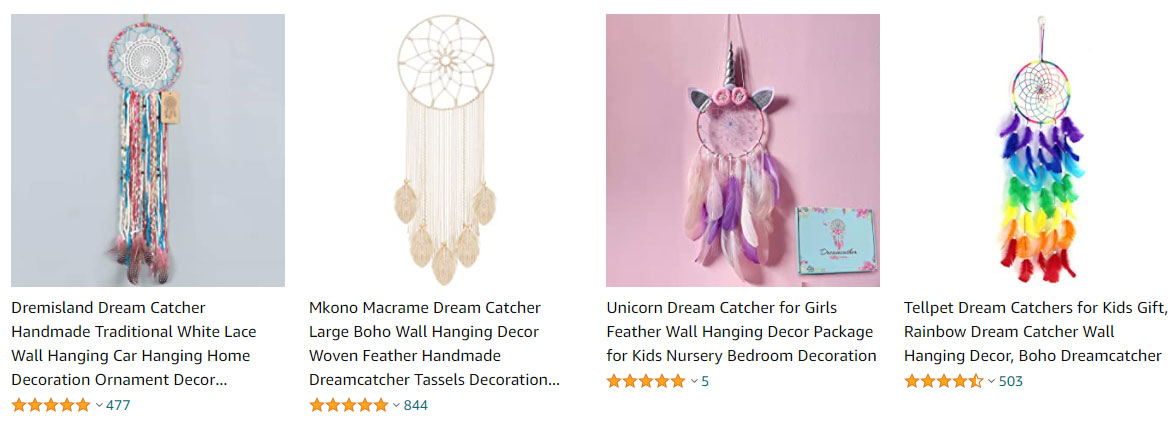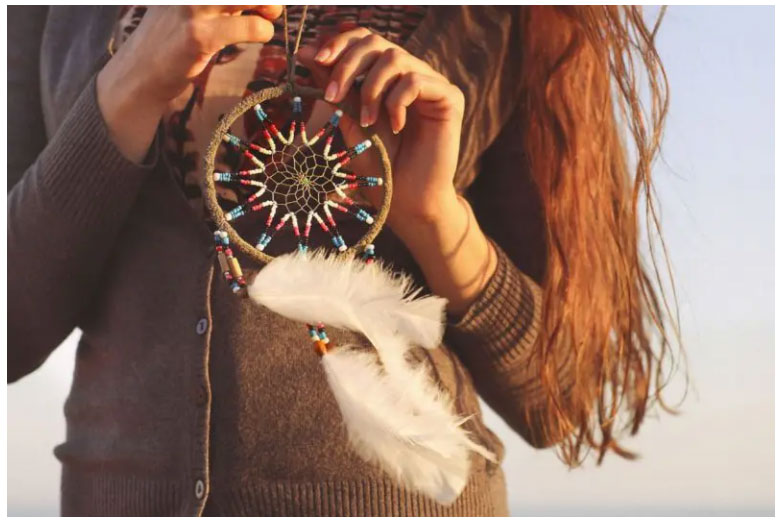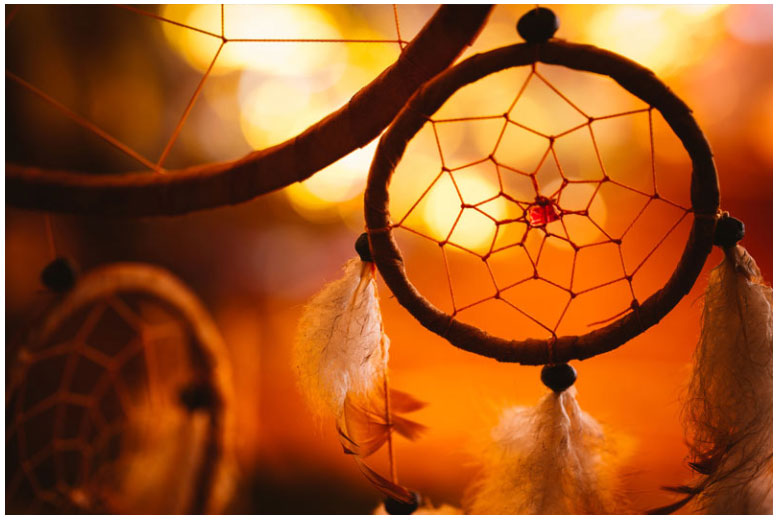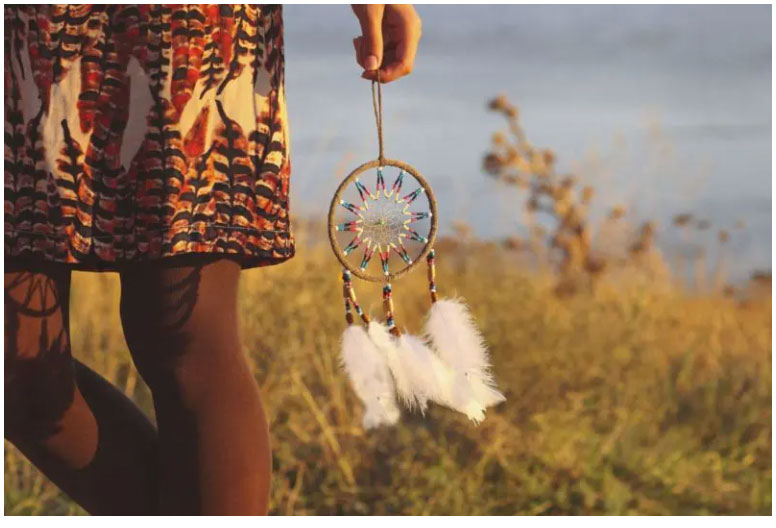Dreamcatcher
Craft piece, tattoo or decorative object, the dream catcher is more than that. This small decorative object, which looks like a woven spider's web, is full of the history of an entire tribe. Its legend goes back a very long time, to the time of the Amerindians. If the dream catcher is nowadays hung in bedrooms, it has the virtue of protecting from bad dreams. Back to the meaning and history of this small object.
What is the dream catcher?
A very trendy object nowadays to decorate the bedroom, especially that of a child, the dream catcher acts as a dream catcher. This handmade piece, in its simplest form, consists of a circle, a woven fabric inside the circle and various decorative objects such as feathers, laces, ribbons or beads, etc.
The dream catcher, as its name suggests, means that it catches dreams. Its ultimate goal is to protect the sleep of its owner, filtering bad dreams and letting good dreams pass by. The traditional model of the dream catcher is made in the shape of a circle, but more and more manufacturers are adapting other shapes such as the triangle, the square or the shape of a heart.
Origin of the dream catcher
The dream catcher is a handcrafted piece that comes from the Amerindian culture. Several legends revolve around its origin, depending on the tribes. But its greatest origins go back to the Ojibwe or Lakota tribes. Three great stories are indeed, at the origin of the dream catcher.
The Legend of the Hunter
This legend tells the story of a hunter who left to find food for his family and his tribe. After several days of walking, without finding anything, the man became tired and stopped to rest. He then decided to rest in a cave where he met an evil spirit in the guise of a huge and terrifying beast. Taken by a terrible fear, the man ran away and returned home. Haunted by the spirit of this beast, the man did not stop having bad dreams, the nights that followed.
One day, when he returned to the forest, the man, tired of his sleepless nights, found himself asleep in the middle of the forest. When he woke up, he was very surprised that he had not had any bad dreams. When he got up, he saw a spider's web, beaded by the morning dew, close to the tree where he had fallen asleep. He deduced then that this spider web was the one that protected him from his bad dreams.
When he returned to his tribe, the convinced man decided to make an object in the shape of a spider's web which he hung in his hut. The tribe did the same and began to weave the web to capture bad dreams. It adorned the web with beads to symbolize the morning dew that had settled on the spider web.

The legend of the spider woman
This legend is the most widely told, as far as dream catcher is concerned. This story dates back to the time of the Ojibwe tribe of Canada. It tells that a spider woman, named "Asibikaashi" is considered the benevolent spirit over children. The spider woman would weave the web every night to catch the first rays of sunlight and bring it back to the village.
Later, the Ojibwe tribe began to expand and the spider woman could no longer watch over all the children of the tribe. She decided to create an object that could replace her with all the children to ensure that they remained protected. She then ordered all the spiders to weave webs in the wooden rings that made up the villages of the Ojibwe tribe. The purpose of this dream catcher was to protect the natives from evil spirits and especially from bad dreams.
The spider webs on the wooden rings were called sacred circles. Later, the villagers and the shamans, convinced of the power brought by the sacred circles, decided to make a dream catcher themselves. This one was made of a willow wood circle with 8 dots weave which represented the legs of the spider. The dream catcher brought peace and serenity to the village during the night and woke the tribe in joy and good mood.
The Legend of the Great Spirit
The legend of the Great Spirit is the one that tells the story of the dream catcher of the Lakota tribe in America. It is told that in this tribe, the people were haunted by bad dreams and evil spirits. The children were often frightened and tired. Faced with this phenomenon, the chief of the village decided to evoke all the wise men of the tribe.
It was then that a great shaman went off into the forest to invoke the spirits and to think calmly about what was happening to his tribe. During his meditation, the great sage met the Great Spirit of the forest. He appeared in the form of a spider and explained to the sage that his people were influenced by both positive and negative forces and that they needed a filter to keep the positive energies. The Great Spirit would then weave a web to guide the wise man in his choices.
Back in the village, the Wise Man told the rest of the tribe about his encounter with the Great Spirit and convinced them to make an object in the shape of a spider web. They all then set to work making webs in a circle of sage. The purpose of this object is to filter the bad dreams to pass on the good energies and make the people happy again. The first dream catchers were born. Feathers and ribbons were gradually added.

The dream catcher, a symbolic object
According to the various legends around the dream catcher, this object has only one purpose: to capture bad dreams or bad spirits that revolve around the people during their sleep. The dream catcher is used to filter dreams, to imprison nightmares and to let good dreams pass. But more than that, the dream catcher has become quite a symbolic object in belief and spirituality. The dream catcher is used to filter the bad experiences of life in order to keep only the good ones and to collect the positive forces.
According to Native American legends, the dream catcher must be made by oneself for its protective effects to be more powerful. If a person decides to make a dream catcher as a gift, it must be the person who made it, who offers the gift in person to the person receiving it. Several beliefs are associated with dream catchers. In addition to its power to filter out evil spirits, the dream catcher could also, in some tribes, read the future. Several beliefs around the dream catcher are that it should be placed in the window for it to work, others believe that it should be placed on the bed.
The meaning of the dream catcher
Each element that makes up the dream catcher carries an important meaning for all the Amerindian tribes. This is why in the making of the dream catcher, the elements have been carefully chosen, both in terms of material and shape :
The hoop
The dream catcher is round in shape and represents a circle. The circle is supposed to represent the cycle of life. This includes all the elements around human life such as earth, planets, moon, sun, water, fire, the cycle of day and night, but also the variations of the seasons. The hoop also represents the sun that brings the positive forces.
The hoop is usually made of a branch of red sage. In Native American culture, sage is used to purify souls and places, but also to chase away evil spirits. That is why it was carefully chosen to form the dream catcher.
The weaving
The traditional weaving of the dream catcher is based on the spider's web. But the number of contacts with the sage circle represents different meanings which are distributed as follows:
• If the weave makes 7 anchor points at the circle, it means the 7 foundations of the Amerindian culture.
• If the weave has 8 anchor points, it represents the 8 spider legs.
• If the weave makes 13 anchor points on the circle, this represents the 13 phases of the moon.
The hole in the center of the dream catcher is the passage of good dreams. While the web is used to filter out bad dreams, bad spirits or negative energies. The canvas also allows to catch the first rays of sunlight which are supposed to bring peace and serenity during the day.
The central pearl
In some models of dream catchers, there is a pearl in the center of the weave of the fabric. The central pearl signifies the presence of the spider. In some Native American tribes, especially the Lakota, the spider represents the Great Spirit. In the Ojibwe, the central bead represents the spider woman protecting children. It is especially the protective spirits who guide the tribes and protect them during their sleeps.
Feathers
Feathers are a symbol of lightness, softness, but also of air. It is the first foundation of the Amerindian culture. Feathers are chosen because they allow dreams to flow down to the owners of the object. In addition, feathers also make it possible to create the link between men and the Great Protective Spirit.
Beads and ribbons, as well as feathers are also intended to collect the dreams that have passed through the holes, that is, the positive energies that have been allowed to pass.

Understanding the Amerindian culture to understand the dreamcatcher
In the Amerindian culture, the dream catcher is a symbol in its own right. It represents an essential element without which the tribes could not live. Thus, they made the dream catchers according to the foundations of the Amerindian culture. These foundations rest on 7 essential points which are :
Air: The air represented by the feathers in the dream catcher means life, the air we breathe. It also represents the wind.
Spirits: Spirits are very important and occupy a large part of belief and spirituality in Native American culture. Spirits could take many forms and appearances. In the origin of dream catchers, spirits were represented by spiders.
The cardinal points: The cardinal points were their points of reference in relation to time and space. The North, South, East and West indicated the direction to be taken, but were also used as landmarks during various ceremonies and rituals.
The Land: The Amerindian culture cherishes the land very much and considers it as a genitor. It is from the land that all kinds of life comes from. Thus, it must be protected, respected and also taken care of. The Amerindians lived in perfect harmony with the land. They maintained it so that it could continue to generously offer the land to future generations.
The cycle: The life of the Amerindians followed cycles: days and nights, sun and moon, movement of the earth and the planets, birth and death.
Prayer: The Native Americans were true spiritual people. They associated themselves with the Great Spirit through prayer. It is a bond that unites them to life and soul.
The name: Among Native Americans, each name given to a newborn child has a great significance. Often, the name is obtained through a vision after a dream, but also to honor a loved one who has passed away.
The 13 phases of the moon
The dream catcher is also made according to the 13 phases of the moon. The phases of the moon were a kind of landmark in time, a kind of calendar for the Amerindians. To each lunar cycle corresponds a name according to the period in which the phase occurs. Each moon symbolizes the forces of nature that feed every human being.
Spirit Moon (January): the moment when spirits dance in the Sky.
Bear Moon (February): The Bear wakes up and brings healing.
Ice Layer Moon (March): Early Spring.
Broken Snowshoe Moon (March-April): Renewal of creation, healing.
Sugar Moon (April): maple sap is collected to make a remedy that cleans the blood.
Moon of the Suckerfish (May): the suckerfish purifies the water that gives life to the one who drinks it.
Berry Moon (July): berries represent fertility and the cycle of life.
Rice Moon (August): means the time of the harvest.
Moon of change of the leaves (September): it means the acceptance of the change.
Jelly Moon (November): means the time of rest.
Moon of the Little Spirit: it is the moment when ancestors and those who have just left are celebrated.
The dream catcher is more than just a trendy decorative object. It represents a link between the positive energies, spirituality and beliefs of Native American tribes. It is a symbol of life that must be taken care of so that it can give complete satisfaction to the person who holds it.


